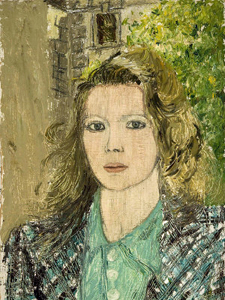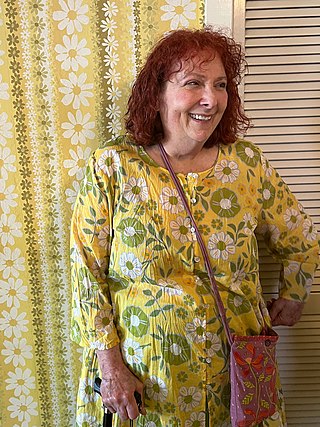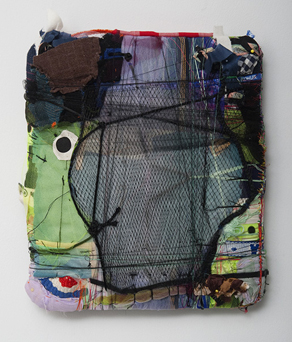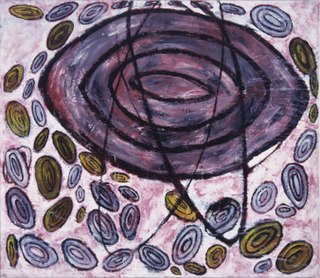
Nancy Spero was an American visual artist. Born in Cleveland, Ohio, Spero lived for much of her life in New York City. She married and collaborated with artist Leon Golub. As both artist and activist, Nancy Spero had a career that spanned fifty years. She is known for her continuous engagement with contemporary political, social, and cultural concerns. Spero chronicled wars and apocalyptic violence as well as articulating visions of ecstatic rebirth and the celebratory cycles of life. Her complex network of collective and individual voices was a catalyst for the creation of her figurative lexicon representing women from prehistory to the present in such epic-scale paintings and collage on paper as Torture of Women (1976), Notes in Time on Women (1979) and The First Language (1981). In 2010, Notes in Time was posthumously reanimated as a digital scroll in the online magazine Triple Canopy. Spero has had a number of retrospective exhibitions at major museums.
Barbara Kruger is an American conceptual artist and collagist associated with the Pictures Generation. She is most known for her collage style that consists of black-and-white photographs, overlaid with declarative captions, stated in white-on-red Futura Bold Oblique or Helvetica Ultra Condensed text. The phrases in her works often include pronouns such as "you", "your", "I", "we", and "they", addressing cultural constructions of power, identity, consumerism, and sexuality. Kruger's artistic mediums include photography, sculpture, graphic design, architecture, as well as video and audio installations.

Hannah Wilke (born Arlene Hannah Butter; was an American painter, sculptor, photographer, video artist and performance artist. Wilke's work is known for exploring issues of feminism, sexuality and femininity.
Cheri Gaulke is a visual artist and filmmaker most known for her role in the Feminist Art Movement in southern California in the 1970s and her work on gay and lesbian families.

Sylvia Sleigh was a Welsh-born naturalised American realist painter who lived and worked in New York City. She is known for her role in the feminist art movement and especially for reversing traditional gender roles in her paintings of nude men, often using conventional female poses from historical paintings by male artists like Diego Vélazquez, Titian, and Jean-Auguste-Dominique Ingres. Her most well-known subjects were art critics, feminist artists, and her husband, Lawrence Alloway.

Sonya Rapoport was an American conceptual, feminist, and New media artist. She began her career as a painter, and later became best known for computer-mediated interactive installations and participatory web-based artworks.
Carol Heifetz Neiman was an American artist who was a member of the feminist art movement of the 1970s, known for her surrealist and xerox art. She also created etchings, and worked in pencil, pastels, and mixed media and was a painter.

Anna Bella Geiger, is a Brazilian multi-disciplinary artist of Jewish-Polish ancestry, and professor at the Escola de Artes Visuais do Parque Lage. She lives in Rio de Janeiro, and her work, characterized by the use of different media, is held by galleries and private collections in the US, China, Brazil and Europe.

Nancy Davidson is an American artist best known for large-scale inflatable sculptures regarded as hyper-feminized abstractions of the human female form. Bulbous and flesh-like, the sculptures resemble buttocks and breasts and employ erotic cultural signifiers in their shape and decoration. Davidson's work spans art media but centers around sculpture. It is largely post-minimal in character and described by commentators as providing a feminist counterpoint to the male-dominated, minimalist sculpture of the 1960s, as well as to cultural tropes involving bodies that the works themselves invoke. Of particular note are Davidson's use of humor and a sense of absurdity to seemingly both celebrate and subvert these tropes, inviting their investigation but without the seriousness and moralism that often accompany critical works. Sculpture Magazine critic Robert Raczka wrote that "The confectionary color and oversize scale" of Davidson's sculpture creates a "playfully upbeat mood that allows feminist and gender issues to rise to the surface at irregular intervals, without didacticism." The New Art Examiner's Susan Canning described it as establishing "a context where all can revel in the transgressive and liberating power of the grotesque."

Phyllis Green is an artist and educator based in the Los Angeles area. She has largely focused on sculpture using a wide range of materials and fabrication techniques to explore objects and their social context, gender politics, consumerism and spirituality, but has also produced video, installation and performance art. Critics characterize her work by its craft and engagement with surface appearance, diverse sources, unconventional juxtapositions, and grounding in the female body and metaphorical content. Her early work grew out of 1970s feminism and consciousness-raising, while her later work has taken inspiration from the Vedanta branch of Hindu spirituality. In 2018, Sculpture critic Kay Whitney wrote, "Green's polymorphously perverse and experimental thinking counters art historical assumptions regarding gender and culture, while her pun-making glittering and whimsical imagery acts as a shadow-screen for the serious and profound."

Nancy Youdelman is a mixed media sculptor who lives and works in Clovis, California. She also taught art at California State University, Fresno from 1999 until her retirement in 2013. "Since the early 1970s Youdelman has been transforming clothing into sculpture, combining women's and girl's dresses, hats, gloves, shoes, and undergarments with a variety of organic materials and common household objects.

Maria Porges is an American artist and writer based in the San Francisco Bay Area. As an artist she is known for the prominent use of text in her visual works, which encompass sculpture, works on paper and assemblage and have an epistemological bent. As a critic Porges has written for Artforum, Art in America, Sculpture and SquareCylinder, among other publications.

Sheila Pinkel is an American visual artist, activist and educator whose practice includes experimental light studies, photography, conceptual and graphic works, and public art. She first gained notice for cameraless photography begun in the 1970s that used light-sensitive emulsions and technologies to explore form; her later, socially conscious art combines research, data visualization, and documentary photography, making critical and ethical inquiries into the military-industrial complex and nuclear industry, consumption and incarceration patterns, and the effects of war on survivors, among other subjects. Writers identify an attempt to reveal the unseen—in nature and in culture—as a common thread in her work.

Coleen Sterritt is an American sculptor known for abstracted, hybrid works made from a myriad of everyday objects and materials, combined in unexpected ways. Writers root her work in the tradition of post-minimalists Jackie Winsor, Eva Hesse and Nancy Graves, and assemblage artists such as Louise Nevelson, Robert Rauschenberg and Marisa Merz; she is sometimes associated with contemporaries Jessica Stockholder, Nancy Rubins, and Tony Cragg. Sculpture critic Kay Whitney suggests Sterritt's work "expands and reinterprets three of the most important artistic inventions of the 20th Century—collage, abstraction and the readymade"— in play with the traditions of Arte Povera bricolage and Surrealist psychological displacement. Curator Andi Campognone considers Sterritt one of the most influential post-1970s artists in establishing "the Los Angeles aesthetic" in contemporary sculpture, while others identify her as an inspiration for later West Coast artists creating hand-made, free-standing sculpture counter to trends toward interventions, public art and environmental works. Constance Mallinson writes that Sterritt's work "walks a line between charm and threat, the natural, the industrial and the hand fabricated, rejecting easy associations for complex reads." Los Angeles Times critic David Pagel calls it smart, funky and "subtly rebellious" in its refashioning of discarded material, dumpster finds, and art-historical lineages.

Elizabeth King is an American sculptor and writer known for movable figurative sculptures that she has employed in stop-frame animations. Her work combines exacting handcraft, elementary mechanics, and digital and electronic technologies, applied in sculptures of half or full figures, heads, arms and hands, or even simply eyes. She often equips figures with subtly illuminated eyes and visible and invisible mechanisms enabling the performance of anatomically correct simple operations, seemingly of their own volition. Writers have described her figures as "insistently nonhuman" yet "uncannily alive" in their ability to project self-awareness, intelligence, agency and emotion. They reflect her interests in early clockwork automata, the history of the mannequin and puppet, literature involving unnatural figures come to life, and human movement. Art in America critic Leah Ollman wrote that King's "highly articulated automatons invite us to consider how consciousness arises from physical being … she portrays her mechanical surrogates as convincingly self-aware, while we are left to ponder that age-old question: where exactly does the self reside?"

Julia Couzens is a California-based, American artist known for a diverse body of work that embraces unconventional materials and methods and includes drawing, sculpture, installation art, and writing. Critic David Roth identifies as a connecting thread in her evolving work, her "decidedly surrealist-symbolist sensibility, in which eroticism, the grotesque and the gothic mix in equal parts." Her work has been shown internationally and throughout the United States, including solo exhibitions at the Christopher Grimes Gallery and California State University, Stanislaus (2009), in surveys at the University of California, Davis and Sonoma Museum of Visual Art (1999), and group shows at the Crocker Art Museum, P•P•O•W, Orange County Museum of Art, Hammer Museum, and BAMPFA, among others. Her art has been reviewed in the Los Angeles Times, San Francisco Chronicle, Flash Art, New Art Examiner, and Art Practical, among other publications, and collected by institutions including the Crocker Art Museum, Fine Arts Museums of San Francisco, Oakland Museum of California and Butler Institute of American Art, among many. In addition to working as an artist, Couzens has taught at several Southern California universities and writes about contemporary art for The Sacramento Bee and Squarecylinder. She lives and works on Merritt Island in the Sacramento River delta community of Clarksburg and maintains a studio in downtown Los Angeles.

Elizabeth Sher is an American visual artist, known for eclectic short films, documentaries about women, art, aging and health, and mixed-media artwork employing digital and analog modes. Her films combine humor, honesty and an interest in everyday experiences; while not strictly autobiographical, her work often explores issues that parallel her own life cycle. The San Francisco Examiner described her early short films as "witty combinations" of music and imagery, formal experimentation, clever editing and rewarding interviews, "infused with arch satire"; Amalia Mesa-Bains wrote that her documentaries create "that special mix of common sense, irony and human insight [that] inspires us to talk more, laugh a lot and trust each other." Sher's films have screened at the Kennedy Center and the London, Edinburgh, Hong Kong and Raindance international film festivals, and been broadcast on PBS and public television networks throughout the world; they have been recognized with awards from the American Film Institute, National Education Media Arts Fest, and the Mill Valley and Bare Bones International film festivals, among others. Her art has been exhibited internationally and belongs to the public collections including the San Francisco Museum of Modern Art and Berkeley Art Museum and Pacific Film Archive (BAM/PFA). Sher lives and works in Oakland, California and exhibits with the collective, Mercury 20 Gallery.
Aline Mare is an American visual artist, performing artist and filmmaker who creates photo-based, hand-finished, multimedia works combine alternative processes and digital technology, remixing nature-based imagery to create surreal compositions that hover between creation and decay.

Nancy Selvin is an American sculptor, recognized for ceramic works and tableaux that explore the vessel form and balance an interplay of materials, minimal forms, and expressive processes. She emerged in the late 1960s among a "second generation" of Bay Area ceramic artists who followed the California Clay Movement and continued to challenge ceramic traditions involving expression, form and function, and an art-world that placed the medium outside its established hierarchy. Her work has been exhibited at the Los Angeles County Museum of Art (LACMA), Denver Art Museum, Daum Museum of Contemporary Art and Kohler Arts Center, and belongs to the public art collections of LACMA, the Smithsonian Institution, Oakland Museum of California, and Crocker Art Museum, among others. Critic David Roth has written, "Selvin's position in the top rank of ceramic artists has come through a process of rigorous self-examination … what differentiates [her] is that she eschews realism and functionality, indicating a level of intellectual engagement not always found among ceramicists." Writer and curator Jo Lauria described Selvin's tableaux as "elegiac and stylistically unified" works that serve as "forceful essays on the relationship between realism and abstraction, object and subject, decoration and use." Selvin lives and works in the Berkeley, California area.

Joan Moment is an American painter based in Northern California. She emerged out of the 1960s Northern California Funk art movement and gained attention when the Whitney Museum of American Art Curator Marcia Tucker selected her for the 1973 Biennial and for a solo exhibition at the Whitney in 1974. Moment is known for process-oriented paintings that employ non-traditional materials and techniques evoking vital energies conveyed through archetypal iconography. Though briefly aligned with Funk—which was often defined by ribald humor and irreverence toward art-world pretensions—her work diverged by the mid-1970s, fusing abstraction and figuration in paintings that writers compared to prehistoric and tribal art. Critic Victoria Dalkey wrote that Moment's methods combined chance and improvisation to address "forces embodied in a universe too large for us to comprehend, as well as the … fragility and transience of the material world."



















